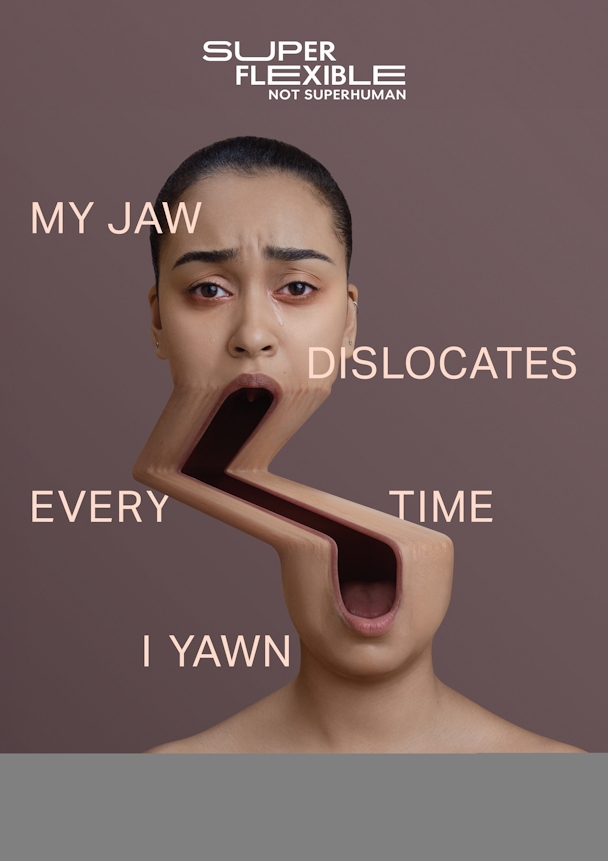EDS sufferers pain made visible by WMH&I
Winning Gold at The Drum Awards for Design in Print is WMH&I and TEM-PLE with Super Flexible Not Superhuman. Here is the award-winning case study.

Sufferers of the condition informed the design response / Superflexible
This is the story of how the visceral power of design made the world wince in empathy with sufferers of Ehlers-Danlos Syndrome by visualising their invisible pain for all to feel.
While a flexible body is often considered a gift, for Ehlers-Danlos Syndrome sufferers (EDS) it means chronic, even life-limiting pain through regular joint dislocation, skin scarring, organ fragility and debilitating fatigue.
The problem is that the pain and damage hyper flexibility causes is largely invisible. Gaslighting causes further suffering. “But you look normal”, “You’re a hypochondriac.” Even GPs lack awareness of EDS meaning the average diagnosis takes 10 years!
Our goal was to get EDS on society’s radar with a Christmas single and campaign to raise awareness among undiagnosed sufferers, GPs, and the wider public, helping people understand that hyper flexibility could be EDS.
Want to go deeper? Ask The Drum
Strategy
We needed to lay bare the painful truth behind hyper flexibility but when visualised it can look like a superpower, more commonly associated with Olympic gymnasts. The breakthrough came from the desperation expressed by one sufferer; ‘See me, hear me, feel me, recognise EDS’.
Our design needed visceral impact to help people finally ‘see sufferers’ by ‘feeling their otherwise invisible pain’.
Here comes the science. People’s instinct is to look away from other’s pain because it feels painful. Scientists attribute this to mirror neurons which enable us to feel what others are going through. So, when we say ‘seeing is believing’, we really mean ‘seeing is feeling’ thanks to the mirror neuron effect.
Advertisement
Design response
We asked sufferers to describe the type of pain they felt to give us a sense of how to visualise it. Their descriptions were so graphic they not only gave us an understanding of what we needed to capture but also the headline copy to express it.
Working with photographer Kristina Varaksina we set out to capture the rawness and vulnerability they expressed, then used CGI to visualise the pain described in their quotes. Natural skin tones and textures were then remapped onto the images.
All the design choices come back to highlighting the invisible pain and suffering of EDS sufferers. Beyond the key visuals, the hyper flexibility design ran through the logo mark which stretches and contracts in digital formats. The campaign landing page showed the model’s head held in her hands but as you scroll down you reveal the hyper flexibility through retouched visuals of stretched skin. The invites to the launch event worked in a similar way and as they unfolded, they reveal the pain of the sufferer. As you unfold the invitation card it feels like the jaw is snapping and popping out of place for the sufferer. For the Christmas single, we added the campaign key visual of one of our EDS models to the record sleeve so that as you pull out the record from the sleeve you see her skin stretch. Even the transparency of the vinyl and posters were designed to amplify the fragility sufferers feel towards their bodies.
The hauntingly beautiful campaign ‘Super Flexible Not Superhuman’ ran in print, posters, DM, on record sleeves and digital screens. Incredibly, the campaign launch was also gifted a 5 minute takeover of the Piccadilly Lights, the largest advertising display in Europe, during rush hour and appeared on the UK’s tallest screen, The Axis Tower in Manchester. The combined reach of these flagship media sites would be tens of thousands of people.
Advertisement
Results
The campaign site received an estimated 29K views and was picked up by publications around the world with a combined audience of 726K. Most importantly, the campaign has had a positive impact on the lives of sufferers who feel ‘seen’ for the first time and hopeful of what greater awareness may bring.
“It took 39 years of being medically gaslighted for me to get a diagnosis… I’m hoping that bringing such huge awareness will start to bring about a new era and a change going forward for us, I cannot thank you enough.”
Further research confirmed ‘seeing is feeling’ with 73% of respondents (from a survey of 157 adults) claiming they could ‘almost feel the pain of the sufferers’ in the images and the majority of the medical professional respondents we spoke to said, the campaign made them want to find out more.
It’s just a start but we’ve finally unlocked the invisible suffering of EDS for all to feel.
Suggested newsletters for you
Ready to get your work recognized on a global stage? Enter The Drum Awards today. Need more inspiration, read our Award Winning Case Studies.
